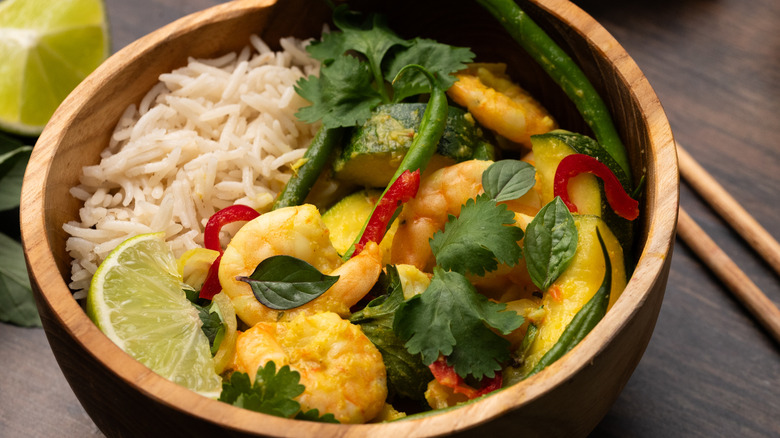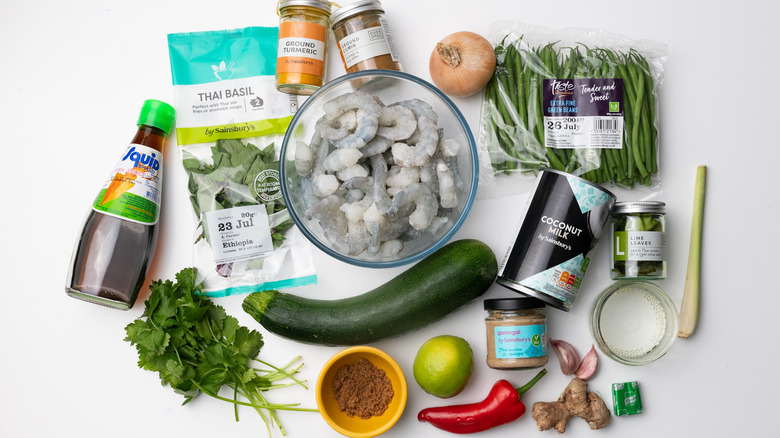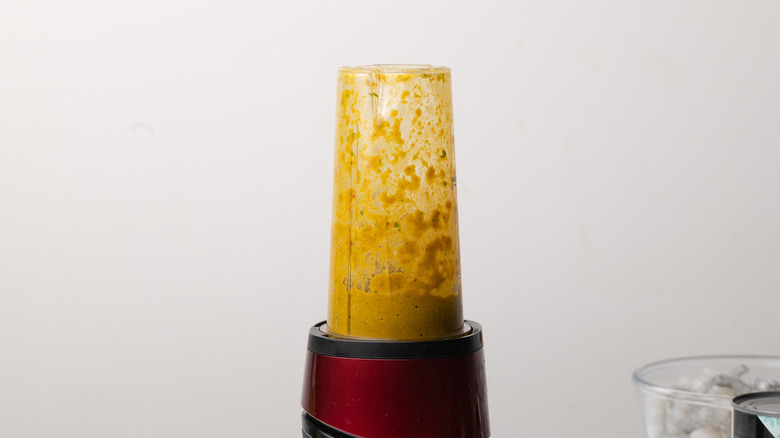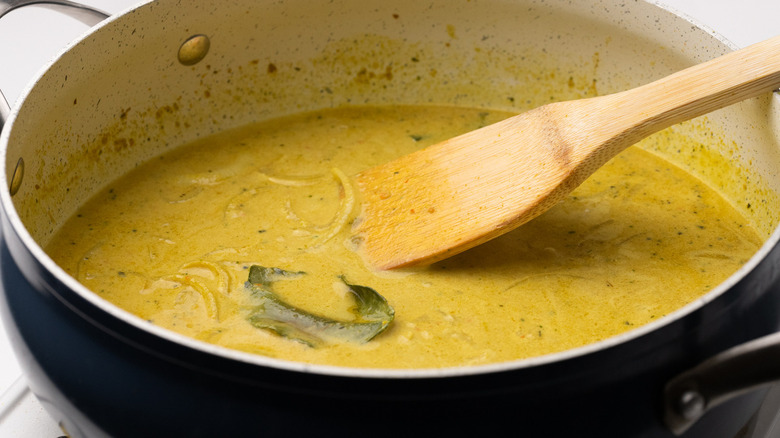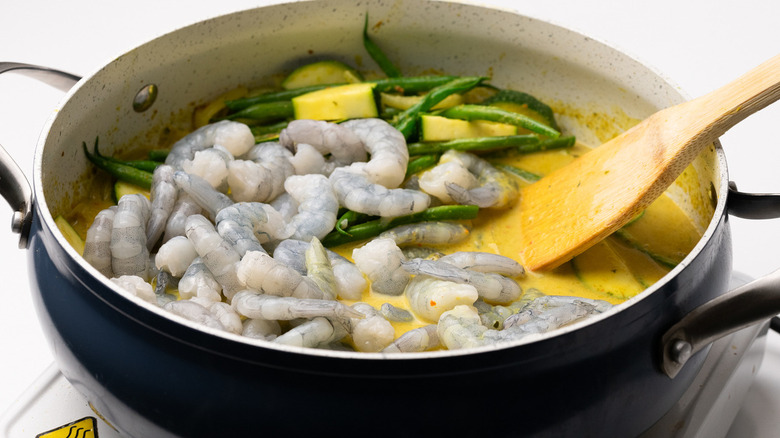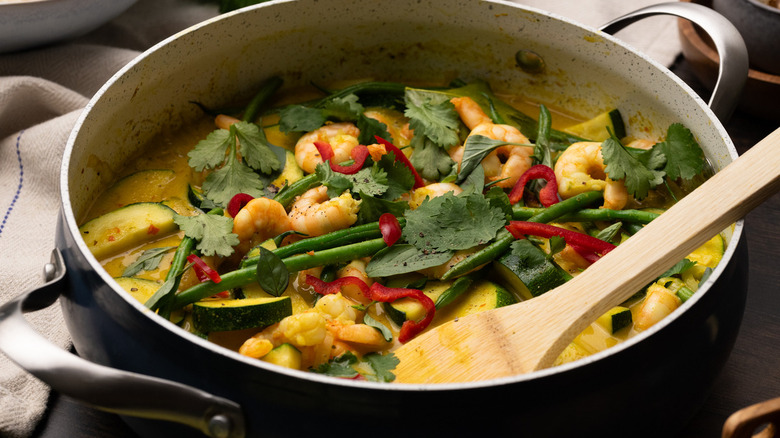Fresh, Aromatic Thai Shrimp Curry Recipe
Thai curry is one of the most popular types of curry in the world. This fresh, aromatic Thai shrimp curry from recipe developer Jennine Rye is a great example of yellow curry, with turmeric giving the dish that distinctive hue. "I love how this curry is packed full of fresh and fragrant flavors; it's a really wonderful mixture of fresh, bright ingredients, warming spices, and rich creamy sweetness," Rye describes. She also appreciates the fact that the curry works well with the shrimp "without overshadowing it," and she enjoys the added crunch that the zucchini and green beans provide.
One huge perk to this recipe is that it features a homemade curry paste, which provides a certain freshness that truly can't be replicated with the store-bought stuff. "Making your own curry paste is a quick and deceptively simple way to take your curries up a notch or three," Rye says. She explains that the flavors of premade pastes may change, deteriorate, or weaken over time, which means that you're losing quite a bit of flavor when it comes time to make the curry.
As a final tidbit of wisdom, Rye says, "It can seem really intimidating making your own curry paste, but it really is as simple as putting things into a food processor and blending everything, and it is well worth it."
Gather the ingredients for this fresh, aromatic Thai shrimp curry
As mentioned, you'll start this recipe by making a from-scratch curry paste. To make it, you'll need fresh ginger, a red chile, garlic cloves, Makrut lime leaves, a lemongrass stalk, galangal paste, ground cumin, ground turmeric, cilantro stems with the leaves, and a little bit of water. Rye enjoys the fact that making a homemade paste means it's inherently customizable, and she says, "If cilantro tastes like soap to you, omit it! If you don't like the heat that ginger can bring, put a little less." Of course, you can apply this notion to any aforementioned ingredient that you aren't a huge fan of.
To build the rest of the curry you'll need groundnut oil, an onion, coconut milk, vegetable oil, brown sugar, shrimp, zucchini, green beans, fish sauce, lime juice, and some Thai basil leaves. And, you may want to have some extra cilantro on hand to garnish the finished dish.
Blend up the curry paste
You'll need either a food processor or blender to make the curry paste, and if you opt for the latter, it's best to use a small one. Add the peeled ginger, red chile, garlic cloves, lemongrass, galangal paste, cumin, turmeric, cilantro, and 1 to 2 tablespoons of water to your processor or blender. You may want to start with 1 tablespoon of water and add more depending on the consistency of the paste. Blend everything together until a smooth paste forms — it should be somewhat thick, but not so thick that the ingredients aren't fully blended together.
Build the curry
Place a large frying pan on the stovetop over medium heat and add the groundnut oil and sliced onions, allowing them to cook for a few minutes and soften. Next up add the curry paste to the mix, and allow that to cook for a few minutes as well, just until fragrant.
Pour in the coconut milk and vegetable stock next, then add in the brown sugar and Makrut lime leaves. Mix it all together and give the liquid a chance to heat up.
Add in the vegetables and shrimp
Make sure your zucchini is sliced up before adding it to the pan along with the green beans and shrimp. These ingredients won't take long to cook — give them about 3 to 4 minutes, until the shrimp is cooked to pink and the vegetables have softened but still have a nice crunch to them. For the final additions, mix in the fish sauce and lime juice.
Serve the fresh, aromatic curry with Thai basil
When it comes to serving, be sure to garnish your curry with Thai basil and extra cilantro for an herbaceous addition. And, like most types of curry, this one pairs especially well with rice or noodles, which will add some starchy goodness and help absorb all of that delicious liquid. Whichever way you serve up this curry, something tells us that you'll never want to return to premade pastes after enjoying the fresh (and easy-to-make) one that this recipe has to offer.
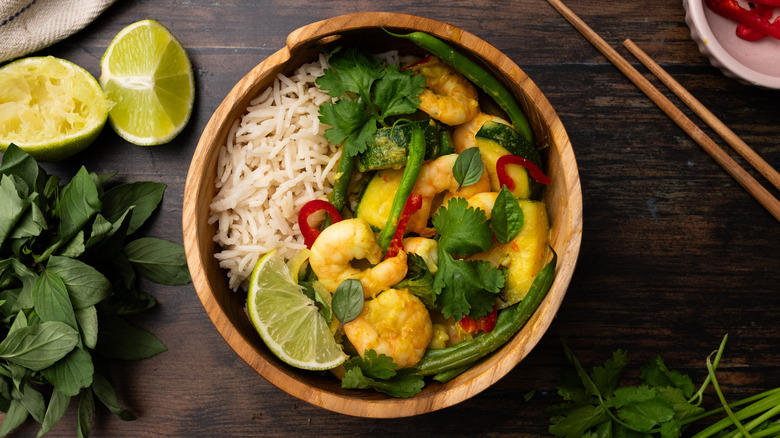
- 1-inch knob fresh ginger, peeled
- 1 red chile
- 2 cloves garlic
- 1 stalk lemongrass
- 1 teaspoon galangal paste
- ½ teaspoon ground cumin
- ½ teaspoon ground turmeric
- 10 cilantro stems with leaves, plus more for garnish
- 1 tablespoon water
- 1 tablespoon groundnut oil
- 1 onion, thinly sliced
- 1 cup coconut milk
- 1 cup vegetable stock
- 1 tablespoon brown sugar
- 2 Makrut lime leaves
- 1 pound raw shrimp, peeled
- 1 zucchini, sliced
- 3 ounces green beans
- 1 teaspoon fish sauce
- ½ lime juice
- 2 tablespoons Thai basil leaves
- Add the ginger, red chile, garlic, lemongrass, galangal paste, ground cumin, ground turmeric, cilantro stalks, and 1 to 2 tablespoons of water to a food processor. Blend the ingredients to form a fragrant curry paste.
- Heat up the groundnut oil in a large frying pan and fry the sliced onions over medium heat for a few minutes until softened.
- Add the curry paste to the pan. Fry the paste for a few minutes until it is fragrant.
- Add the coconut milk and the vegetable stock, along with the brown sugar and the lime leaves, and allow the liquids to heat through.
- Add the zucchini and the green beans to the pan, followed by the shrimp. Cook for 3 to 4 minutes until the shrimp is just cooked and the vegetables are slightly softened but still retain some crunch.
- Add the fish sauce and the lime juice before serving topped with Thai basil leaves and extra cilantro.
- Serve with rice or noodles.
| Calories per Serving | 300 |
| Total Fat | 16.7 g |
| Saturated Fat | 11.2 g |
| Trans Fat | 0.0 g |
| Cholesterol | 182.6 mg |
| Total Carbohydrates | 15.1 g |
| Dietary Fiber | 2.6 g |
| Total Sugars | 6.5 g |
| Sodium | 287.2 mg |
| Protein | 26.4 g |
